Uncategorized
Crypto’s Compliance Conundrum

As Bitcoin continues to rise and institutional investors pour over $20 billion into crypto ETFs, a fundamental shift is occurring in digital asset markets. The appointment of Paul Atkins as SEC Chair, known for favoring market-driven solutions over heavy-handed enforcement, has fueled optimism that crypto can finally balance innovation with regulation.
But the crypto industry faces a stark choice that no amount of regulatory flexibility can overcome: either sacrifice the unlimited programmability that makes these systems revolutionary, or accept that their compliance from an anti-money laundering regulation perspective cannot be fully automated or built into the system. This isn’t a temporary technological limitation about one system or another – it’s as fundamental as the laws of mathematics.
Automating Market Integrity
To begin to see why, we can think about an economy where shells are money. If we pass a law that nobody can transact more than 10 times per day or hold more than 10% of the shells, we have an enforcement problem. How do we know who holds which shells when? Information asymmetry stymies compliance and compliance devolves to a surveillance challenge.
Blockchain technology solves that problem. If everyone sees where all the shells are all the time, then enforcement works. We can build compliance into a system and deny banned transactions. Here, the transparency from the blockchain enables automated compliance.
But the long-held premise of Web3 is to automate stock exchanges and myriad complex interactions. Doing so requires moving beyond shells to a system where users create their own assets and upload their own programs. And permissionless access to publish these complex programs causes trouble for users who may be exposed to malicious programs or scams, the system which may face congestion, and regulators who care about preventing financial crimes.
The core challenge lies in what computer scientists call «undecidability.» In traditional finance, when regulators impose rules like «no transactions with sanctioned entities» or «maintain capital adequacy ratios,» banks can implement these requirements through their existing control systems. But, in a truly decentralized system where anyone can deploy sophisticated smart contracts, it becomes mathematically impossible to verify in advance whether a new piece of code might violate these rules.
JPMorgan’s recent rebranding of Onyx to Kinexys illustrates this reality. The platform now processes over $2 billion in daily transactions, and participation is by participants who meet regulatory criteria before joining. Unlike typical cryptocurrency platforms where anyone can write and deploy automated trading programs (known as smart contracts), JPMorgan’s system maintains compliance by restricting what participants can do.
This approach has attracted major institutional players like BlackRock and State Street, which collectively have more than $15 trillion in assets under management. Many crypto enthusiasts view such restrictions as betraying the technology’s promise. These compromises are not just pragmatic choices – they’re necessary for any system that aims to guarantee regulatory compliance.
The Securities and Exchange Commission’s mandate to protect investors while facilitating capital formation has grown increasingly complex in the digital age. Under Gary Gensler’s leadership, the SEC took an enforcement-heavy approach to crypto markets, treating most digital assets as securities requiring strict oversight. While Atkins’ anticipated principles-based approach might seem more accommodating, it cannot change the underlying mathematical constraints that make automated compliance impossible in permission-less, fully programmable systems.
The limitations of fully automated systems became painfully clear at MakerDAO, one of the largest decentralized lending platforms with over $10 billion in assets. During March 2024’s market turbulence, when Bitcoin’s price swung 15% in hours, MakerDAO’s automated systems began triggering a cascade of forced liquidations that threatened to collapse the entire platform.
Despite years of refinement and over $50 million spent on system development, the protocol required emergency human intervention to prevent a $2 billion loss. Similar incidents at Compound and Aave, which together handle another $15 billion in assets, underscore that this wasn’t an isolated case. This wasn’t just a technical failure – it demonstrates the impossibility of programming systems to handle every potential scenario while maintaining regulatory compliance.
Towards Compliant Crypto
The industry now faces three paths forward, each with distinct implications for investors:
First, follow JPMorgan’s lead by building permission-based systems that sacrifice some decentralization for clear regulatory compliance. This approach has already gained significant traction: six of the top ten global banks have launched similar initiatives in 2024, collectively handling over $2 trillion in transactions. The surge in regulated crypto products, from ETFs to tokenized securities, further validates this path.
Second, limit blockchain systems to simple, predictable operations that can be automatically verified for compliance. This is the approach adopted by Ripple with its newly launched RUSD, designed to be compliant with the New York Department of Financial Services standards based on the limited purpose trust company framework. While this constrains innovation due to the restriction action space that users can make, it enables decentralization within carefully defined boundaries.
Third, continue pursuing unlimited programmability while accepting that such systems cannot provide strong regulatory guarantees. This path, chosen by platforms like Uniswap with its over $1 trillion in total trading volume in 2024, faces mounting challenges. Recent regulatory actions against similar platforms in Singapore, the U.K. and Japan suggest this approach’s days may be numbered in developed markets.
For investors navigating this evolving landscape, the implications are clear. The current market enthusiasm, largely driven by regulated products like ETFs, indicates the industry is moving toward the first option. Projects that acknowledge and address these fundamental constraints, rather than fighting them, are likely to thrive. This explains why traditional financial institutions’ blockchain initiatives, despite their limitations, are seeing dramatic growth – JPMorgan’s platform reported a 127% increase in transaction volume this year.
The success stories in crypto’s next chapter will likely be hybrid systems that balance innovation with practical constraints. Investment opportunities exist in both regulated platforms that provide clear compliance guarantees and innovative projects that thoughtfully limit their scope to achieve verifiable safety properties.
As this market matures, understanding these mathematical constraints becomes crucial for investors’ risk assessment and portfolio allocation. The evidence is already clear in market performance: regulated crypto platforms have delivered average returns of 156% over the past year, while unrestricted platforms face increasing volatility and regulatory risks.
Atkins’ principles-based approach might offer more flexibility than Gensler’s prescriptive rules, but it cannot override the fundamental limits of automated compliance. Just as physics constrains what’s possible in the physical world, these mathematical principles set immutable boundaries in financial technology. The impossible dream isn’t cryptocurrency itself – it’s the notion that we can have unrestricted programmability, complete decentralization and guaranteed regulatory compliance all at once.
For the crypto industry to deliver on its revolutionary potential, it must first acknowledge these immutable constraints. The winners in this next phase won’t be those promising to overcome these mathematical limits, but those who design intelligent ways to work within them.
Uncategorized
AI, Mining News: GPU Gold Rush: Why Bitcoin Miners Are Powering AI’s Expansion

When Core Scientific signed a $3.5 billion deal to host artificial intelligence (AI) data centers earlier this year, it wasn’t chasing the next crypto token — it was chasing a steadier paycheck. Once known for its vast fleets of bitcoin mining rigs, the company is now part of a growing trend: converting energy-intensive mining operations into high-performance AI facilities.
Bitcoin miners like Core, Hut 8 (HUT) and TeraWulf (WULF) are swapping ASIC machines — the dedicated bitcoin mining computer — for GPU clusters, driven by the lure of AI’s explosive growth and the harsh economics of crypto mining.
Power play
It’s no secret that bitcoin mining requires an extensive amount of energy, which is the biggest cost of minting a new digital asset.
Back in the 2021 bull run, when the Bitcoin network’s hashrate and difficulty were low, miners were making out like bandits with margins as much as 90%. Then came the brutal crypto winter and the halving event, which slashed the mining reward in half. In 2025, with surging hashrate and energy prices, miners are now struggling to survive with razor-thin margins.
However, the need for power—the biggest input cost—became a blessing in disguise for these miners, who needed a different strategy to diversify their revenue sources.
Due to rising competition for mining, the miners continued to procure more machines to stay afloat, and with it came the need for more megawatts of electricity at a cheaper price. Miners invested heavily in securing these low-cost energy sources, such as hydroelectric or stranded natural gas sites, and developed expertise in managing high-density cooling and electrical systems—skills honed during the crypto boom of the early 2020s.
This is what captured the attention of AI and cloud computing firms. While bitcoin relies on specialized ASICs, AI thrives on versatile GPUs like Nvidia’s H100 series, which require similar high-power environments but for parallel processing tasks in machine learning. Instead of building out data centers from scratch, taking over mining infrastructure, which already has power ready, became a faster way to grow an increasing appetite for AI-related infrastructure.
Essentially, these miners aren’t just pivoting—they’re retrofitting.
The cooling systems, low-cost energy contracts, and power-dense infrastructure they built during the crypto boom now serve a new purpose: feeding the AI models of companies like OpenAI and Google.
Firms like Crusoe Energy sold off mining assets to focus solely on AI, deploying GPU clusters in remote, energy-rich locations that mirror the decentralized ethos of crypto but now fuel centralized AI hyperscalers.
Terraforming AI
Bitcoin mining has effectively «terraformed» the terrain for AI compute by building out scalable, power-efficient infrastructure that AI desperately needs.
As Nicholas Gregory, Board Director at Fragrant Prosperity, noted, «It can be argued bitcoin paved the way for digital dollar payments as can be seen with USDT/Tether. It also looks like bitcoin terraformed data centres for AI/GPU compute.»
This pre-existing «terraforming» allows miners to retrofit facilities quickly, often in under a year, compared to the multi-year timelines for traditional data center builds. Firms like Crusoe Energy sold off mining assets to focus solely on AI, deploying GPU clusters in remote, energy-rich locations that mirror the decentralized ethos of crypto but now fuel centralized AI hyperscalers.
Higher returns
In practice, it means miners can flip a facility in less than a year—far faster than the multi-year timeline of a new data center.
But AI isn’t a cheap upgrade.
Bitcoin mining setups are relatively modest, with costs ranging from $300,000 to $800,000 per megawatt (MW) excluding ASICs, allowing for quick scalability in response to market cycles. Meanwhile, AI infrastructure demands significantly higher capex due to the need for advanced liquid cooling, redundant power systems, and the GPUs themselves, which can cost tens of thousands per unit and face global supply shortages. Despite the steeper upfront costs, AI offers miners up to 25 times more revenue per kilowatt-hour than bitcoin mining, making the pivot economically compelling amid rising energy prices and declining crypto profitability.
A niche industry worth billions
As AI continues to surge and crypto profits tighten, bitcoin mining could become a niche game—one reserved for energy-rich regions or highly efficient players, especially as the next in 2028 could render many operations unprofitable without breakthroughs in efficiency or energy costs.
While projections show the global crypto mining market growing to $3.3 billion by 2030, at a modest 6.9% CAGR, the billions would be overshadowed by AI’s exponential expansion. According to KBV Research, the global AI in mining market is projected to reach $435.94 billion by 2032, expanding at a compound annual growth rate (CAGR) of 40.6%.
With investors already seeing dollar signs in this shift, the broader trend suggests the future is either a hybrid or a full conversion to AI, where stable contracts with hyperscalers promise longevity over crypto’s boom-bust cycles.
This evolution not only repurposes idle assets but also underscores how yesterday’s crypto frontiers are forging tomorrow’s AI empires.
Uncategorized
Bitcoin Climbs as Economy Cracks — Is it Bullish or Bearish?

Bitcoin (BTC) is about 4% higher than it was a week ago—good news for the digital asset but bad news for the economy.
The recent negative tone of the economic data points from last week raised expectations that the Federal Reserve will cut interest rates on Wednesday, making riskier assets such as stocks and bitcoin more attractive.
Let’s recap the data that backs up that thesis.
The most important one, the U.S. CPI figures, came out on Thursday. The headline rate was slightly higher than expected, a sign inflation might be stickier than anticipated.
Before that, we had Tuesday’s revisions to job data. The world’s largest economy created almost 1 million fewer jobs than reported in the year ended March, the largest downward revision in the country’s history.
The figures followed the much-watched monthly jobs report, which was released the previous Friday. The U.S. added just 22,000 jobs in August, with unemployment rising to 4.3%, the Bureau of Labor Statistics said. Initial jobless claims rose 27,000 to 263,000 — the highest since October 2021.

Higher inflation and fewer jobs are not great for the U.S. economy, so it’s no surprise that the word «stagflation» is starting to creep back into macroeconomic commentary.
Against this backdrop, bitcoin—considered a risk asset by Wall Street—continued grinding higher, topping $116,000 on Friday and almost closing the CME futures gap at 117,300 from August.
Not a surprise, as traders are also bidding up the biggest risk assets: equities. Just take a look at the S&P 500 index, which closed at a record for the second day on the hope of a rate cut.
So how should traders think about BTC’s price chart?
To this chart enthusiast, price action remains constructive, with higher lows forming from the September bottom of $107,500. The 200-day moving average has climbed to $102,083, while the Short-Term Holder Realized Price — often used as support in bull markets — rose to a record $109,668.
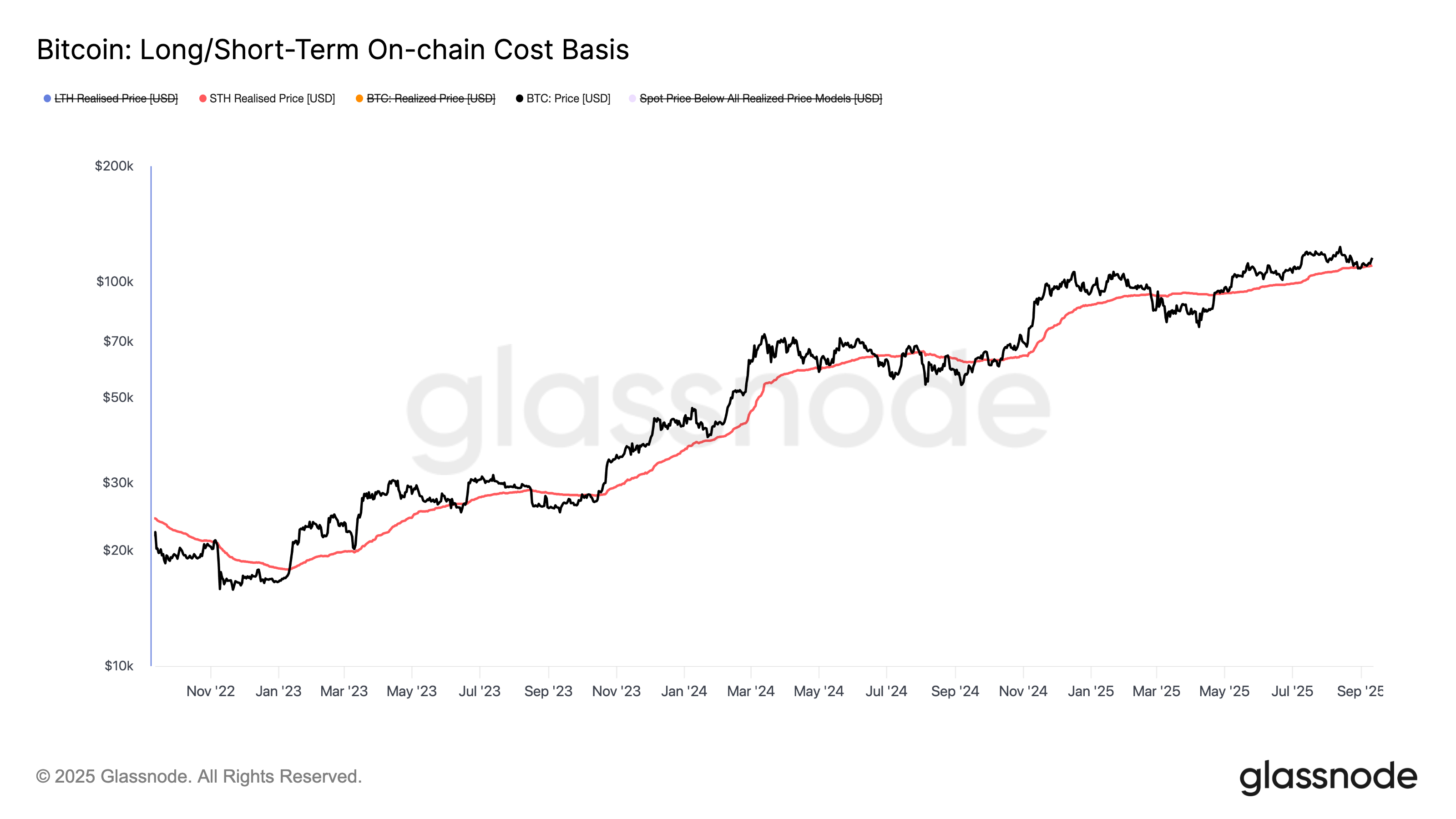
Bitcoin-linked stocks: A mixed bag
However, bitcoin’s weekly positive price action didn’t help Strategy (MSTR), the largest of the bitcoin treasury companies, whose shares were about flat for the week. Its rivals performed better: MARA Holdings (MARA) 7% and XXI (CEP) 4%.
Strategy (MSTR) has underperformed bitcoin year-to-date and continues to hover below its 200-day moving average, currently $355. At Thursday’s close of $326, it’s testing a key long-term support level seen back in September 2024 and April 2025.
The company’s mNAV premium has compressed to below 1.5x when accounting for outstanding convertible debt and preferred stock, or roughly 1.3x based solely on equity value.
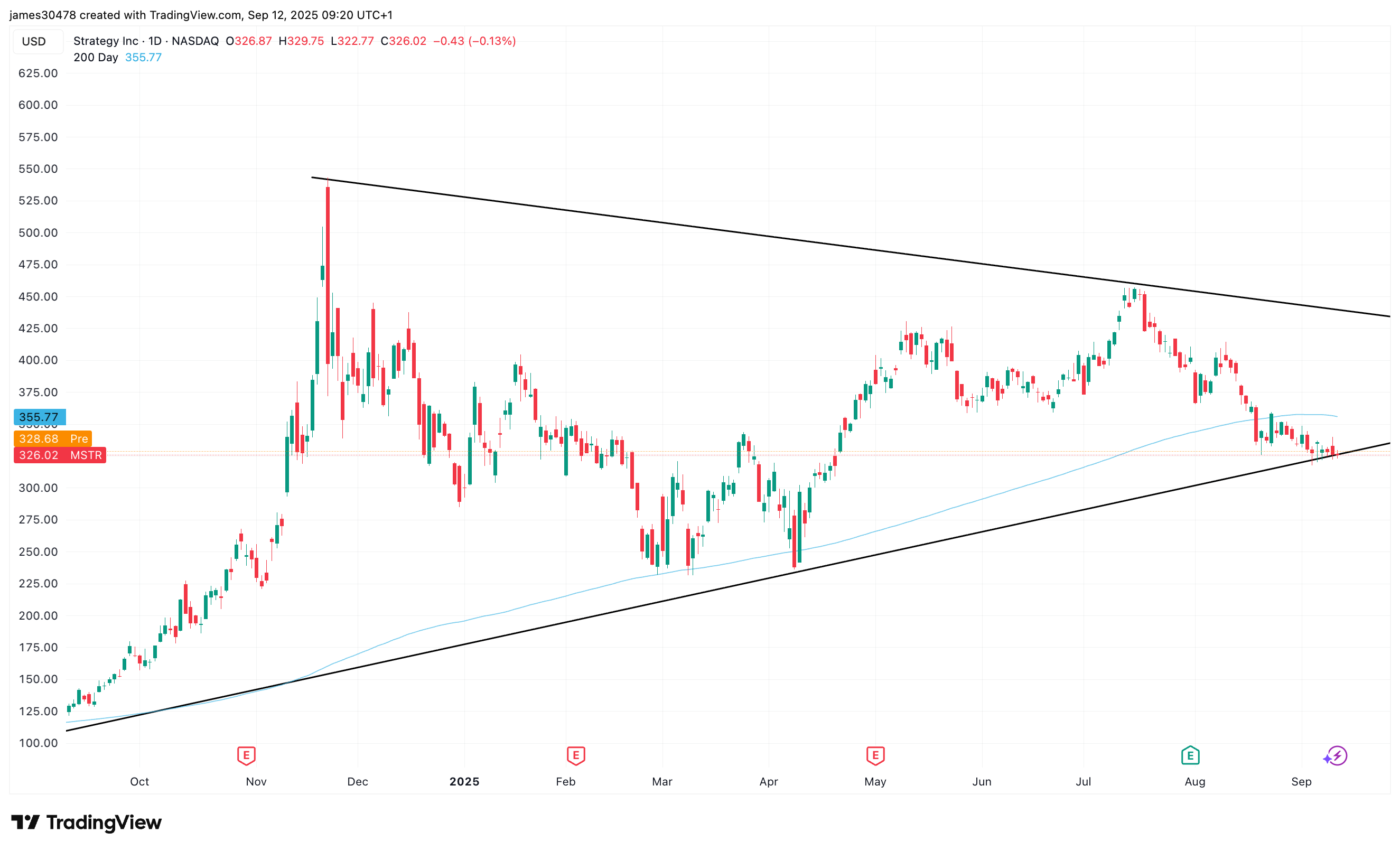
Preferred stock issuance remains muted, with only $17 million tapped across STRK and STRF this week, meaning that the bulk of at-the-money issuance is still flowing through common shares. According to the company, options are now listed and trading for all four perpetual preferred stocks, a development that could provide additional yield on the dividend.
Bullish catalysts for crypto stocks?
The CME’s FedWatch tool shows traders expect a 25 basis-point U.S. interest-rate cut in September and have priced in a total of three rate cuts by year-end.
That’s a sign risk sentiment could tilt back toward growth and crypto-linked equities, underlined by the 10-year U.S. Treasury briefly breaking below 4% this week.
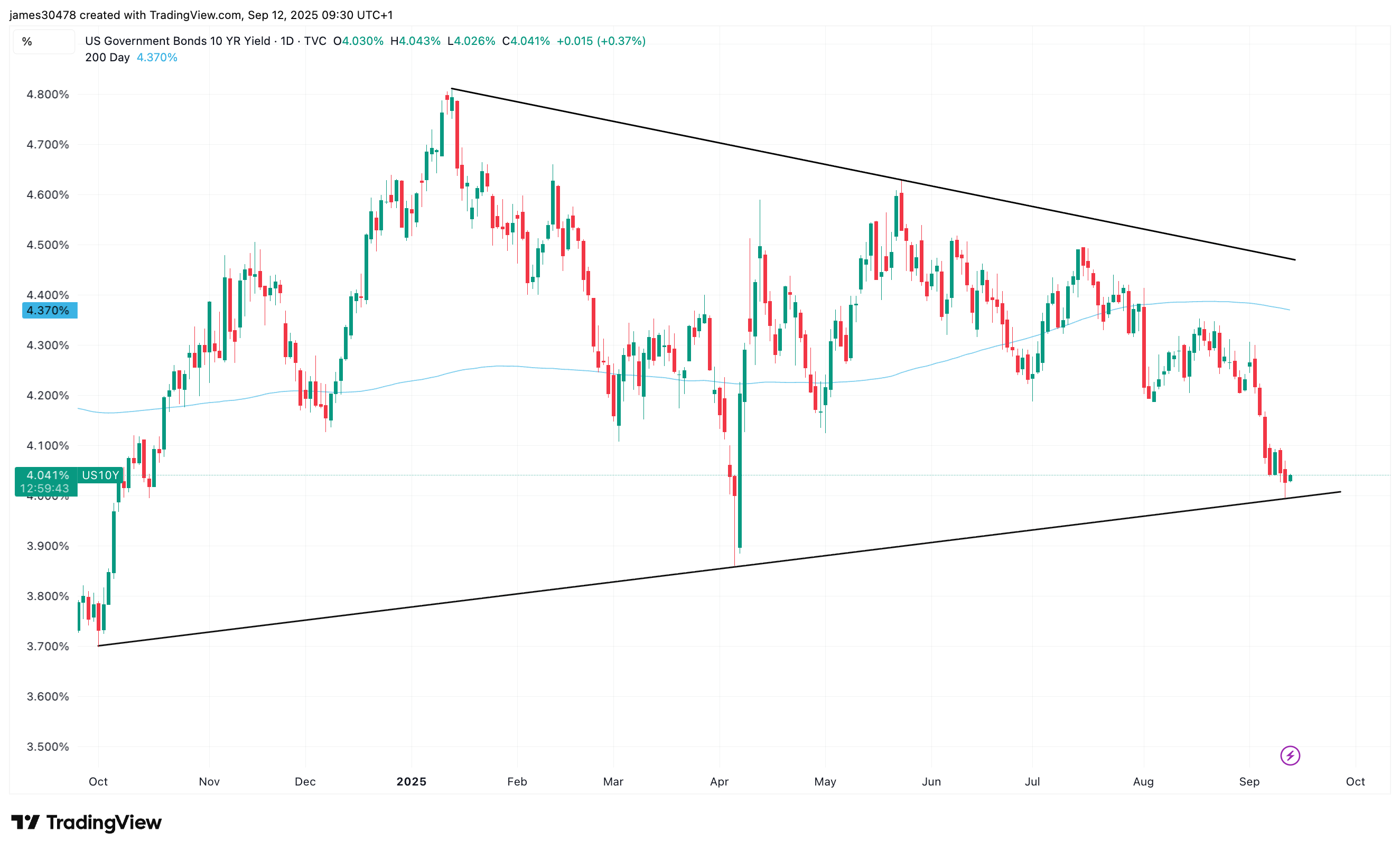
Still, the dollar index (DXY) continues to hold multiyear support, a potential inflection point worth watching.
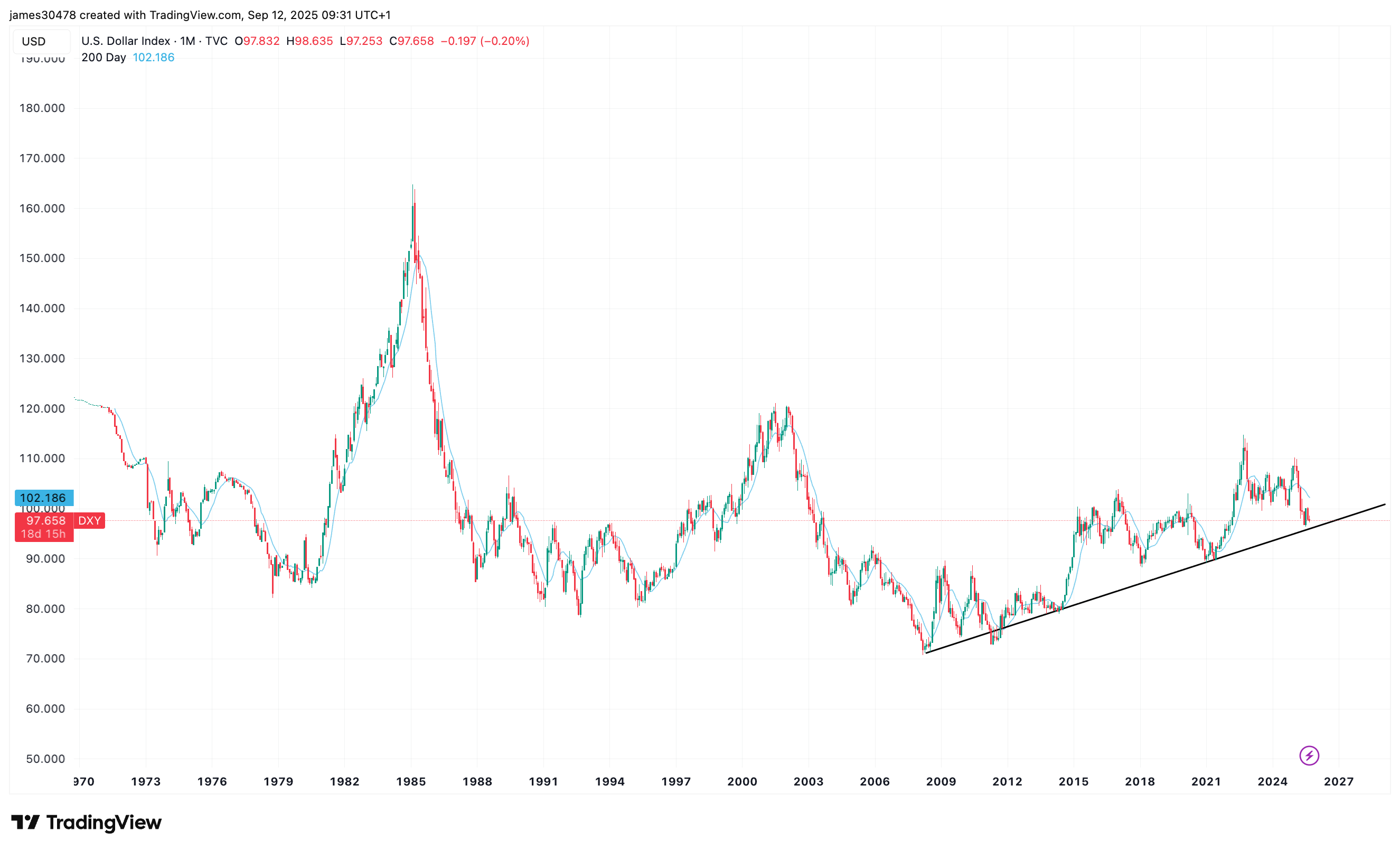
Uncategorized
Fed’s Sept. 17 Rate Cut Could Spark Short-Term Jitters but Supercharge Bitcoin, Gold and Stocks Long Term

Investors are counting down to the Federal Reserve’s Sept. 17 meeting, where markets expect a quarter-point rate cut that could trigger short-term volatility but potentially fuel longer-term gains across risk assets.
The economic backdrop highlights the Fed’s delicate balancing act.
According to the latest CPI report released by the U.S. Bureau of Labor Statistics on Thursday, consumer prices rose 0.4% in August, lifting the annual CPI rate to 2.9% from 2.7% in July, as shelter, food, and gasoline pushed costs higher. Core CPI also climbed 0.3%, extending its steady pace of recent months.
Producer prices told a similar story: per the latest PPI report released on Wednesday, the headline PPI index slipped 0.1% in August but remained 2.6% higher than a year earlier, while core PPI advanced 2.8%, the largest yearly increase since March. Together, the reports underscore stubborn inflationary pressure even as growth slows.
The labor market has softened further.
Nonfarm payrolls increased by just 22,000 in August, with federal government and energy sector job losses offsetting modest gains in health care. Unemployment held at 4.3%, while labor force participation remained stuck at 62.3%.
Revisions showed June and July job growth was weaker than initially reported, reinforcing signs of cooling momentum. Average hourly earnings still rose 3.7% year over year, keeping wage pressures alive.
Bond markets have adjusted accordingly. The 2-year Treasury yield sits at 3.56%, while the 10-year is at 4.07%, leaving the curve modestly inverted. Futures traders see a 93% chance of a 25 basis point cut, according to CME FedWatch.
If the Fed limits its move to just 25 bps, investors may react with a “buy the rumor, sell the news” response, since markets have already priced in relief.
Equities are testing record levels.
Equities are testing record levels. The S&P 500 closed Friday at 6,584 after rising 1.6% for the week, its best since early August. The index’s one-month chart shows a strong rebound from its late-August pullback, underscoring bullish sentiment heading into Fed week.
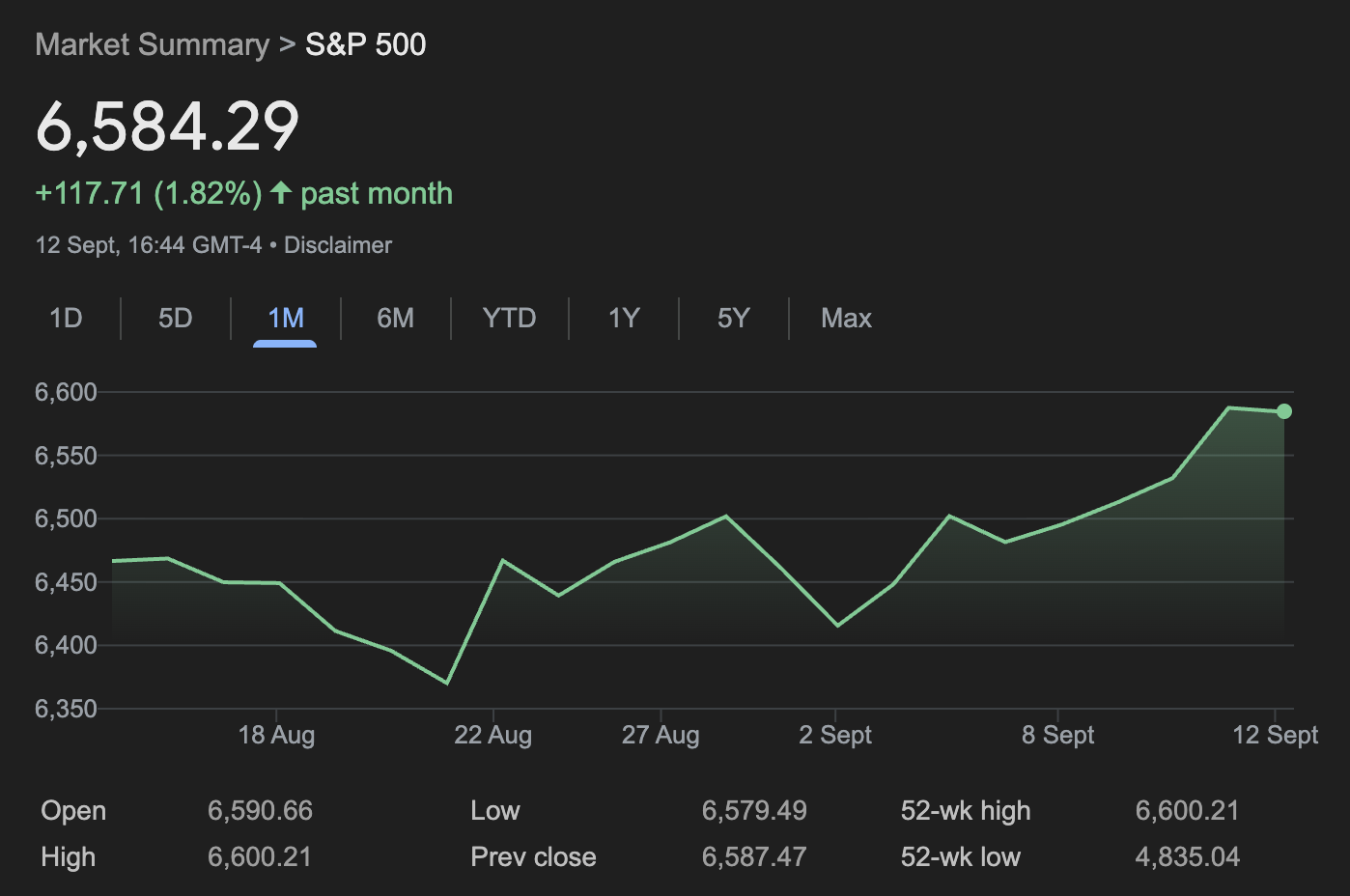
The Nasdaq Composite also notched five straight record highs, ending at 22,141, powered by gains in megacap tech stocks, while the Dow slipped below 46,000 but still booked a weekly advance.
Crypto and commodities have rallied alongside.
Bitcoin is trading at $115,234, below its Aug. 14 all-time high near $124,000 but still firmly higher in 2025, with the global crypto market cap now $4.14 trillion.
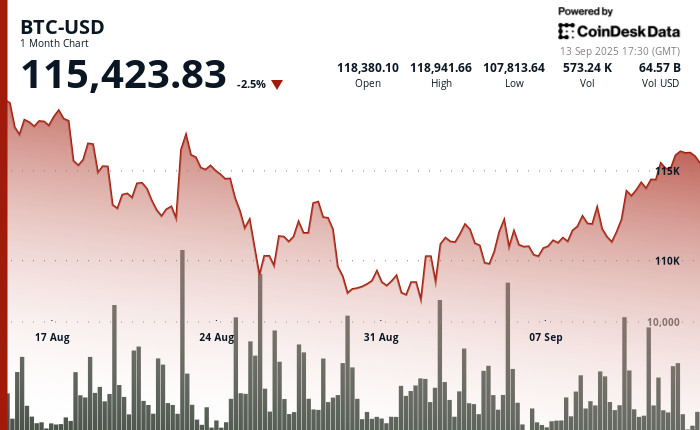
Gold has surged to $3,643 per ounce, near record highs, with its one-month chart showing a steady upward trajectory as investors price in lower real yields and seek inflation hedges.
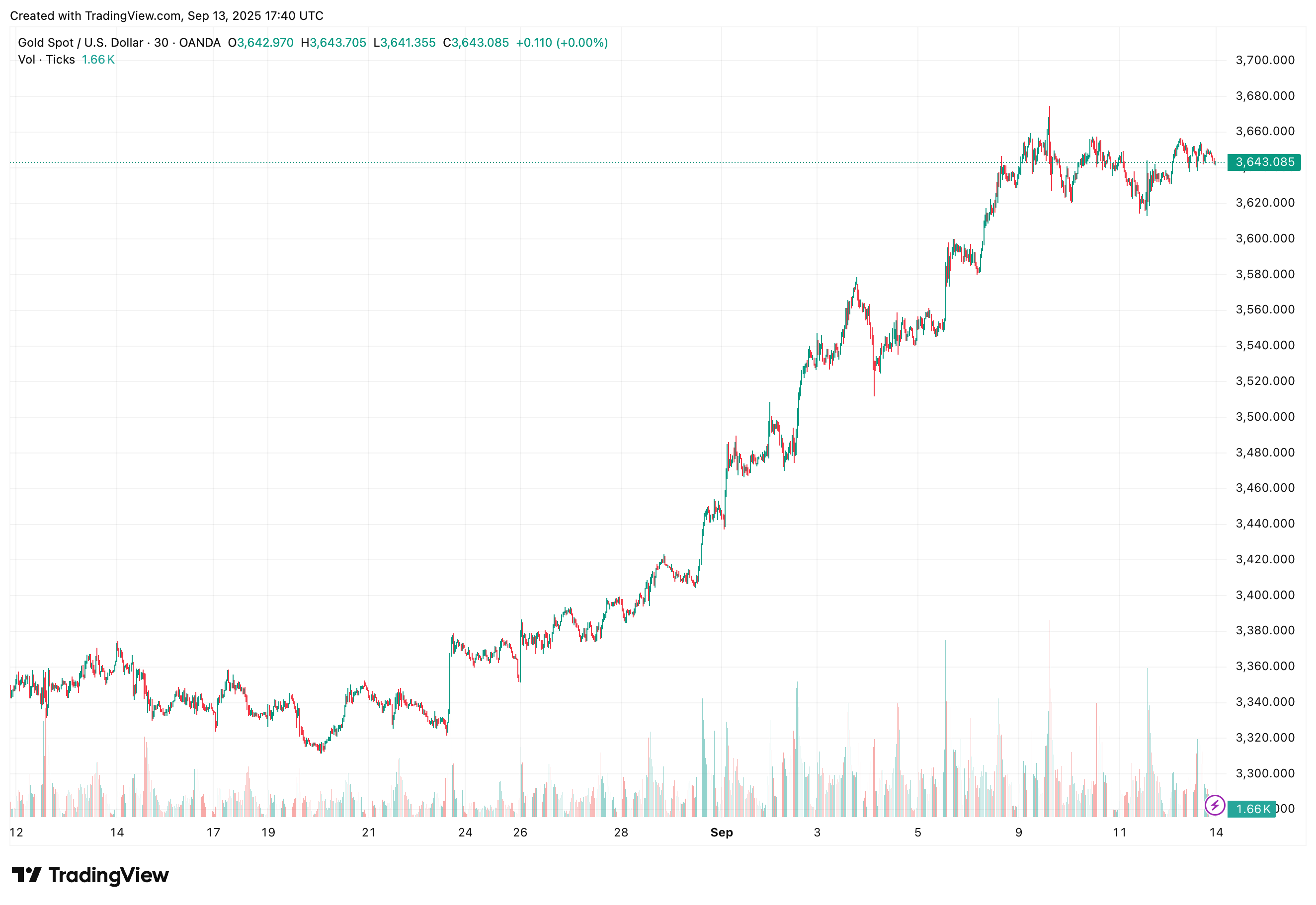
Gold has climbed steadily toward record highs, while bitcoin has consolidated below its August peak, reflecting ongoing demand for alternative stores of value.
Historical precedent supports the cautious optimism.
Analysis from the Kobeissi Letter — reported in an X thread posted Saturday — citing Carson Research, shows that in 20 of 20 prior cases since 1980 where the Fed cut rates within 2% of S&P 500 all-time highs, the index was higher one year later, averaging gains of nearly 14%.
The shorter term is less predictable: in 11 of those 22 instances, stocks fell in the month following the cut. Kobeissi argues this time could follow a similar pattern — initial turbulence followed by longer-term gains as rate relief amplifies the momentum behind assets like equities, bitcoin, and gold.
The broader setup explains why traders are watching the Sept. 17 announcement closely.
Cutting rates while inflation edges higher and stocks hover at records risks denting credibility, yet staying on hold could spook markets that have already priced in easing. Either way, the Fed’s message on growth, inflation, and its policy outlook will likely shape the trajectory of markets for months to come.
-

 Business11 месяцев ago
Business11 месяцев ago3 Ways to make your business presentation more relatable
-

 Fashion11 месяцев ago
Fashion11 месяцев agoAccording to Dior Couture, this taboo fashion accessory is back
-

 Entertainment11 месяцев ago
Entertainment11 месяцев ago10 Artists who retired from music and made a comeback
-

 Entertainment11 месяцев ago
Entertainment11 месяцев ago\’Better Call Saul\’ has been renewed for a fourth season
-

 Entertainment11 месяцев ago
Entertainment11 месяцев agoNew Season 8 Walking Dead trailer flashes forward in time
-

 Business11 месяцев ago
Business11 месяцев ago15 Habits that could be hurting your business relationships
-

 Entertainment11 месяцев ago
Entertainment11 месяцев agoMeet Superman\’s grandfather in new trailer for Krypton
-

 Entertainment11 месяцев ago
Entertainment11 месяцев agoDisney\’s live-action Aladdin finally finds its stars





